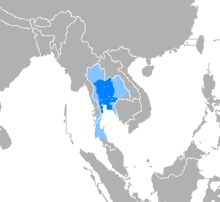Thai Language
| Thai | |
|---|---|
| Siamese | |
| ภาษาไทย Phasa Thai | |
| Pronunciation | [pʰāːsǎː tʰāj] |
| Native to | Thailand |
| Ethnicity | Central Thai and Thai Chinese |
|
Native speakers
|
20 million (2000) 40 million L2 speakers with Lanna, Isan, Southern Thai or Northern Khmer (2001) |
|
Tai–Kadai
|
|
|
Thai script Thai Braille |
|
| Official status | |
|
Official language in
|
Thailand |
| Regulated by | Royal Society of Thailand |
| Language codes | |
| ISO 639-1 | th |
| ISO 639-2 | |
| ISO 639-3 | |
| Glottolog | thai1261 |
| Linguasphere | 47-AAA-b |
 |
|
Thai, also known as Siamese or Central Thai, is the national and official language of Thailand and the native language of the Thai people and the vast majority of Thai Chinese. Thai is a member of the Tai group of the Tai–Kadai language family. Over half of the words in Thai are borrowed from Pali, Sanskrit and Old Khmer. It is a tonal and analytic language. Thai also has a complex orthography and relational markers. Spoken Thai is mutually intelligible with Laotian (Language of Laos; the two languages are written with slightly different scripts, but are linguistically similar).
Thai is the official language of Thailand, natively spoken by over 20 million people (2000). Standard Thai is based on the register of the educated classes of Bangkok. In addition to Central Thai, Thailand is home to other related Tai languages. Although linguists usually classify these idioms as related, but distinct languages, native speakers often identify them as regional variants or dialects of the "same" Thai language, or as "different kinds of Thai".
Siamese Thai is composed of several distinct registers, forms for different social contexts:
...
Wikipedia
